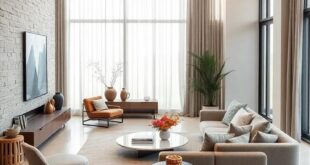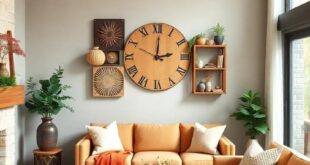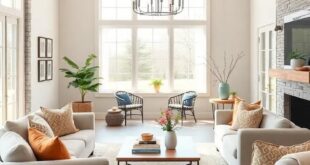In an era where urban living often detaches us from the serene embrace of nature, the concept of integrating greenery into our homes has emerged as a refreshing antidote. Imagine stepping into a living room that flows seamlessly into a kitchen, where the boundaries of indoor and outdoor life blur like the gentle hues of a sunset. This harmonious design approach not only amplifies aesthetic appeal but fosters tranquility and wellbeing. In this article, we’ll explore the art of creating an open concept living space that celebrates nature through strategically placed plants, thoughtful layout choices, and natural materials. Discover how to transform your home into a sanctuary of lush greenery, where every corner invites the calm of the outdoors inside, creating an inviting atmosphere that nurtures both the body and mind.
embracing Open Spaces for Nature’s Flow and Functionality
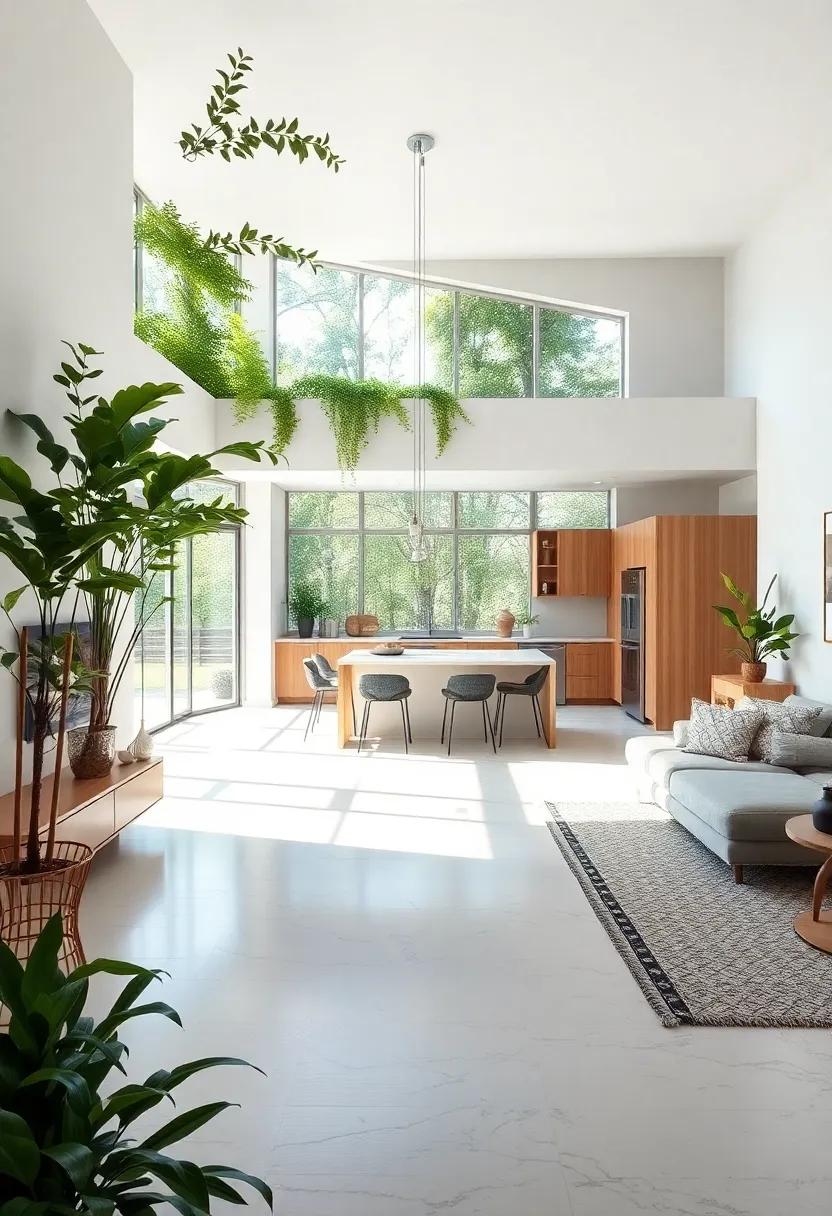
Creating an open-concept living space that harmonizes with nature requires a thoughtful approach to design. One way to seamlessly merge indoor and outdoor environments is by incorporating large windows and glass doors that invite natural light while providing sweeping views of your garden or patio.The use of natural materials—like wood, stone, and organic textiles—enhances this connection. Additionally, consider using a neutral color palette accented with greens, ensuring that the lively colors of plants complement rather than overwhelm the space. Integrating vertical gardens or indoor planters allows for a lively pop of greenery without sacrificing floor space.
Also, functionality is vital when arranging spaces for maximum flow. Designate specific zones for cooking, dining, and lounging that remain visually and physically interconnected. Useful strategies include using multifunctional furniture,such as a kitchen island that doubles as a dining area or a storage bench that provides seating without clutter. Create a biophilic design by strategically placing potted plants and small trees to improve air quality while elevating aesthetics. To further explore the principles of biophilic design,visit biophilic-design.com.
Seamless Transitions between Living Spaces and Lush Greenery

Creating a harmonious flow between indoor and outdoor spaces enriches the living experience, allowing the vibrant beauty of nature to seamlessly integrate into daily life.By incorporating expansive glass doors,large windows,and open layouts,homeowners can connect their interior spaces with the greenery outside. natural materials such as wood and stone can be used in flooring and furniture to enhance this connection,while a carefully curated selection of houseplants brings life and color to the design. consider layering various types of greenery—such as succulents, ferns, and flowering plants—for a dynamic yet cohesive look.
In addition to visual appeal,the strategic placement of green elements can improve indoor air quality and create a soothing atmosphere.Incorporating features like a living wall or vertical garden not only maximizes space but also serves as a stunning focal point. To further embrace nature, think about implementing features like:
- Natural light solutions, such as skylights
- Integrative outdoor spaces like patios or balconies
- Sustainable materials that reflect an eco-amiable mindset
by embracing these elements, homeowners can transform their living environments into tranquil retreats that celebrate both comfort and the beauty of the natural world. For more design inspiration, visit House Beautiful.
Creating Cozy Nooks with Vibrant Indoor Plant Arrangements
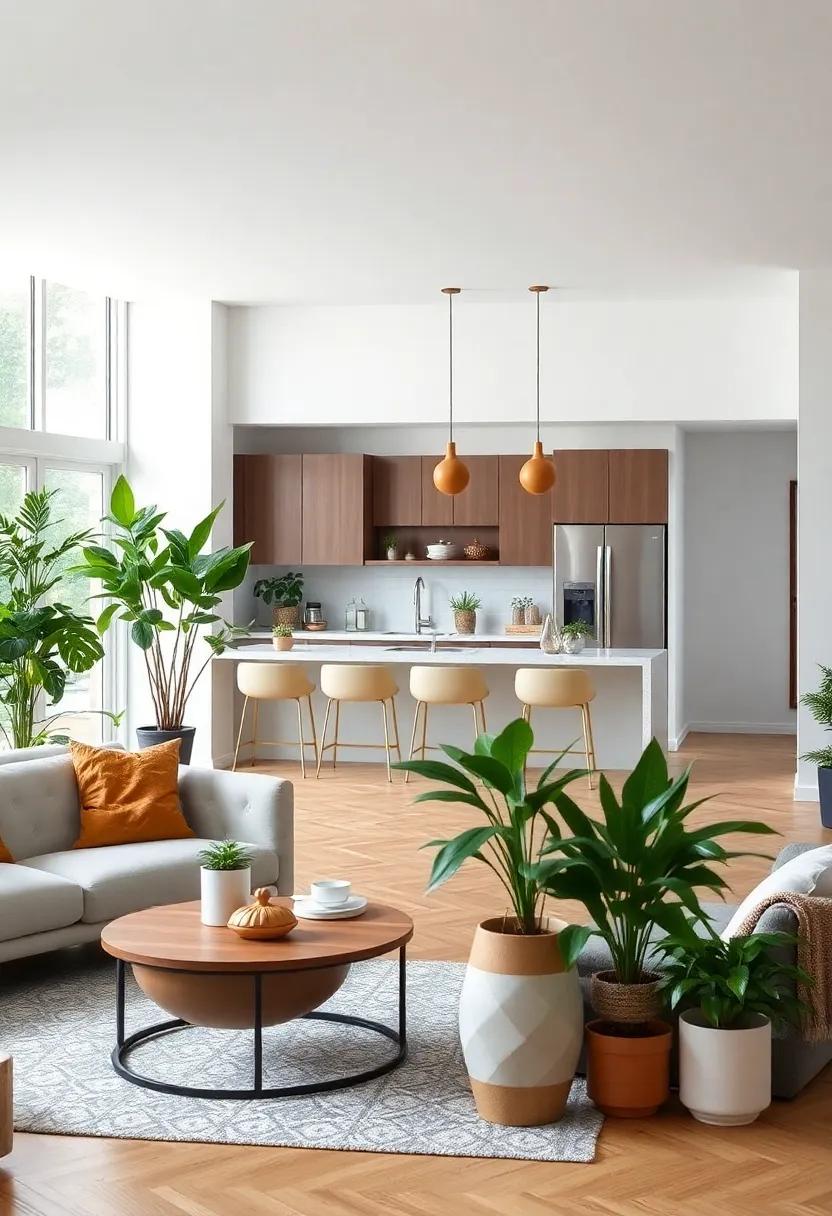
Infuse your open concept living room and kitchen with personality by creating cozy nooks that showcase vibrant indoor plant arrangements. Consider using a variety of plant species to add texture and dimension. Ferns, succulents, and spider plants can thrive in various lighting conditions, making them excellent choices for your space. Use decorative pots or hanging planters to elevate these plants,turning them into focal points that enhance the overall aesthetic. Place a few in corners or alongside seating areas to create inviting retreats where you can unwind and connect with nature.
To maximize visual appeal, try arranging plants at different heights and textures. For instance,tall leafy plants can stand proudly beside low-growing ground covers,creating a dynamic visual interplay. Consider utilizing shelves, side tables, or window sills for additional layering. You might also want to include aromatic plants like basil or mint, bringing not only beauty but also fragrance to your culinary space. Using mirrored surfaces nearby can reflect greenery,enhancing its vibrant beauty even further. For inspiration, explore resources like Apartment Therapy to see how others have beautifully integrated plants into their living spaces.
Incorporating Natural Materials in Open Concept Designs
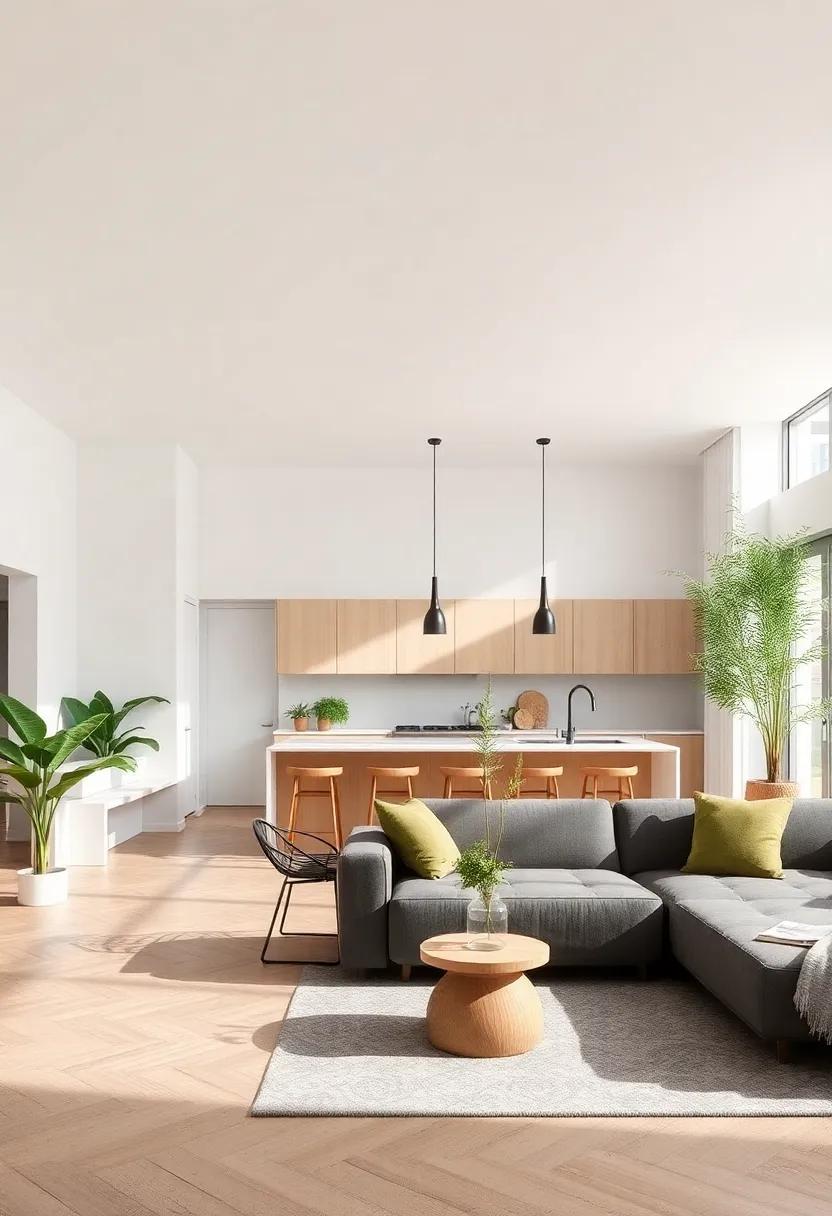
Integrating natural materials into open concept designs can transform your space into a serene oasis that mirrors the beauty of the outdoors. Wood, stone, and bamboo are excellent choices that not only provide aesthetic appeal but also enhance the tactile experience of your living surroundings. Consider incorporating reclaimed wood beams or panels to create a warm and inviting atmosphere, while polished stone surfaces can add a contemporary touch. To break the monotony, choose bamboo furniture that is both sustainable and stylish, offering a perfect contrast to more customary decor elements.
Another innovative approach is to utilize soft furnishings made from natural fibers such as linen, cotton, or jute which can enhance the earthy feel of your space. Strategically placing indoor plants not only boosts air quality but also introduces vibrant hues and texture into your open layout. For instance, hanging planters can create vertical interest, while a centerpiece of succulents can seamlessly blend the kitchen and living areas. To see how natural elements can harmonize with modern aesthetics, explore more on ArchDaily.
Maximizing Natural light with Expansive Windows and Skylights
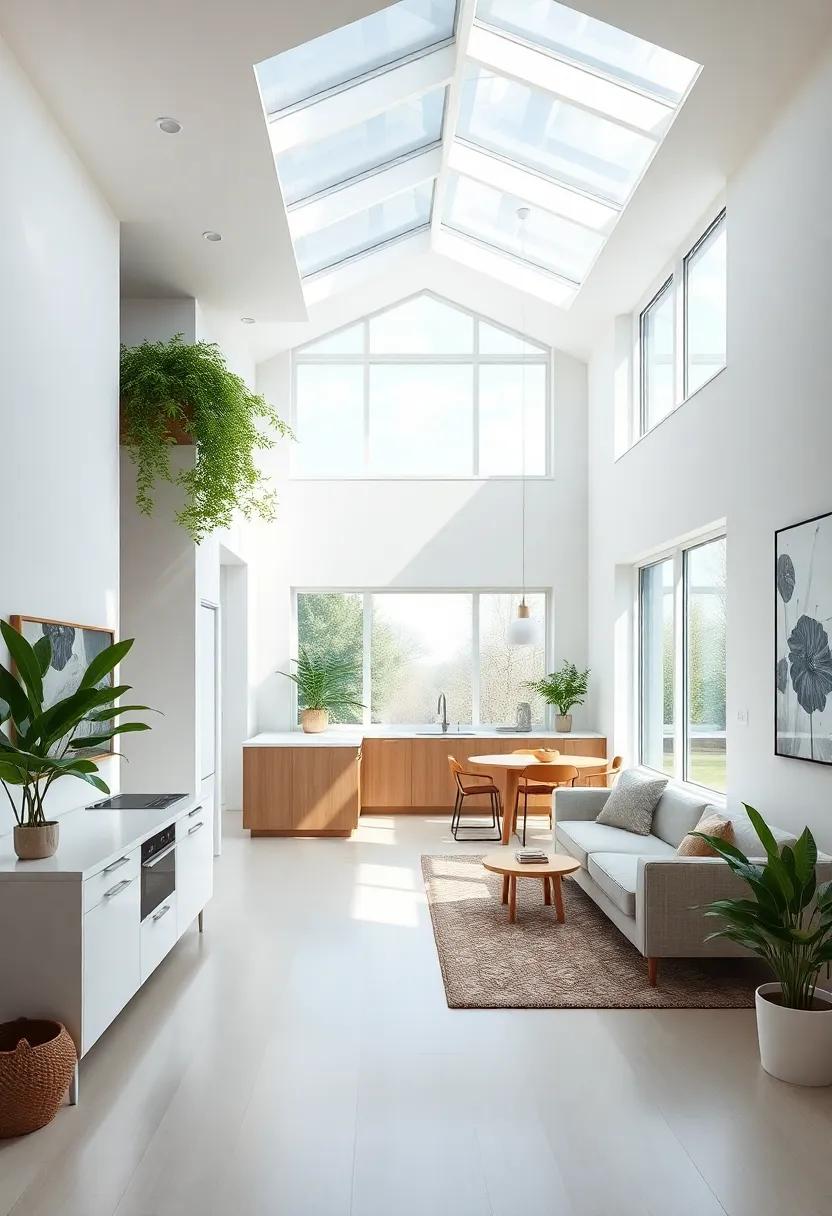
Incorporating expansive windows and skylights into your living space can create a seamless connection between your indoor and outdoor environments. These architectural features not only enhance the aesthetic appeal but also serve a functional purpose by flooding your home with natural light. This infusion of sunlight can reduce reliance on artificial lighting, creating a warm and inviting ambiance while positively impacting your mood. Consider the following benefits of expansive glass:
- Enhanced Aesthetics: Large windows frame the views of your garden or nature, acting as living art.
- Improved Ventilation: Operable windows can facilitate natural airflow, helping to regulate temperature.
- Energy Efficiency: When designed correctly, they can reduce heating and cooling costs.
Skylights are another brilliant addition that can significantly uplift your open-concept living room and kitchen. They not only bring in abundant natural light but also create an illusion of spaciousness. Positioning skylights strategically can illuminate specific areas, emphasizing architectural elements or showcasing your carefully curated greenery. To inspire your design, here’s a unique comparison of skylight types:
| Skylight Type | Features | Best Use |
|---|---|---|
| Fixed Skylights | Passive light, great for sunrooms | Living rooms and hallways |
| Ventilating Skylights | Operable for air flow, great for kitchens | Kitchens and bathrooms |
| Solar Tubes | Compact, ideal for tight spaces | closets and small rooms |
By thoughtfully integrating expansive windows and strategically placed skylights, you can transform your living space into a radiant sanctuary that invites the beauty of the outdoors in. For more inspiration on natural lighting and sustainable design, visit Green Building Advisor.
Stylish Furniture Choices That Harmonize with Nature
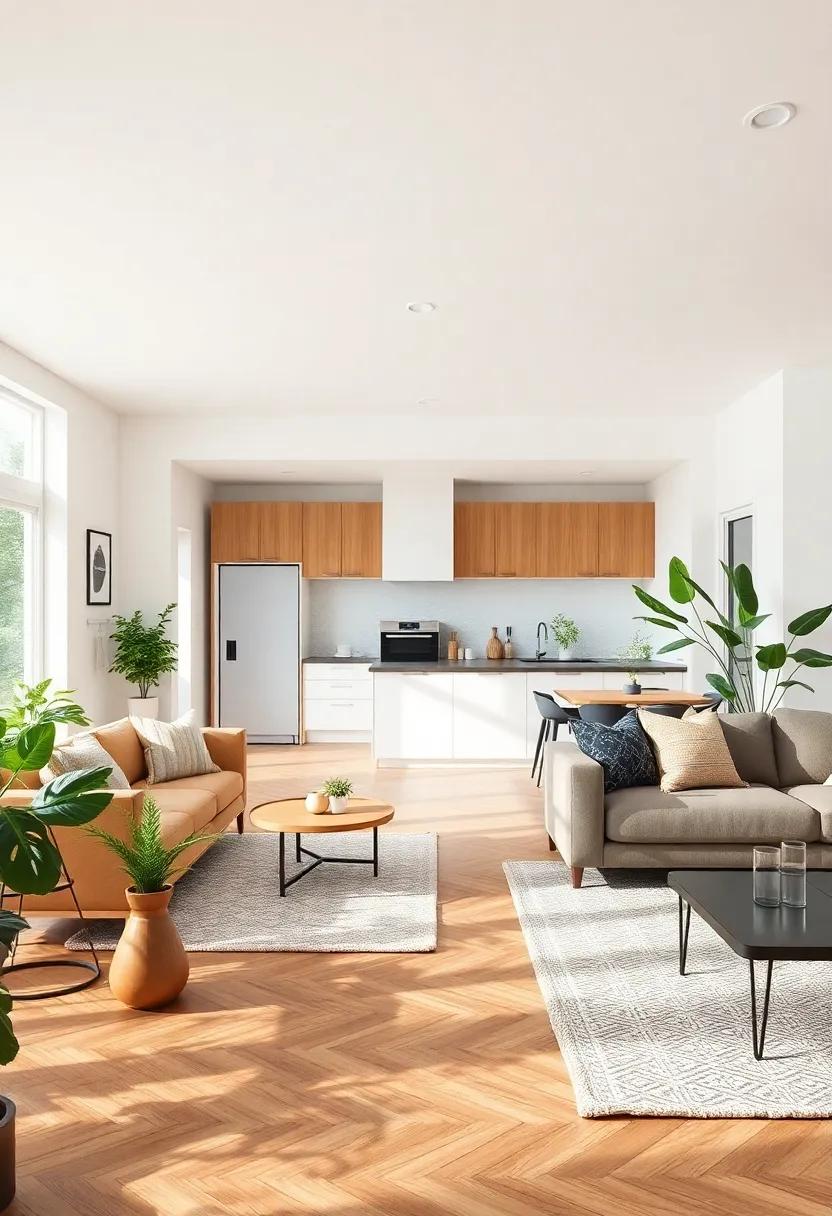
Creating a space that seamlessly connects with the outdoors requires thoughtful selection of furniture that brings a touch of nature indoors. Opt for sustainable materials such as reclaimed wood, bamboo, or rattan, which not only offer a hint of rustic charm but also support eco-friendly practices. Adding soft, earthy tones in your upholstery can enhance this natural vibe, allowing you to evoke a serene atmosphere reminiscent of nature. Incorporating pieces like a low-slung coffee table made of driftwood or a sleek sofa adorned with botanical-patterned cushions can truly create visual harmony between the indoor and outdoor elements.
To further enrich your open-concept design, consider integrating planters directly into your furniture layout. This could range from a built-in shelf system with greenery spilling out or a coffee table designed with an inset for succulents. Key furniture selections might include:
- Organic-Shaped Sofas: Curved designs echo the forms found in nature.
- Natural Fiber Rugs: Jute or sisal rugs provide texture without overshadowing the plants.
- Multifunctional Pieces: Choose furniture with integrated storage for flower pots.
As you curate these stylish choices, don’t underestimate the impact of lighting. Natural light is a pivotal element in showcasing your design, so choose fixtures with a minimalist aesthetic that complements rather than competes with the outdoor view. Consider installing large windows that can open up to a patio, ensuring that your living space flows effortlessly into the lush greenery outside. For more insights on merging interiors with nature,check out Architectural Digest for inspiration.
The Role of Color Palettes in Bringing the Outdoors In
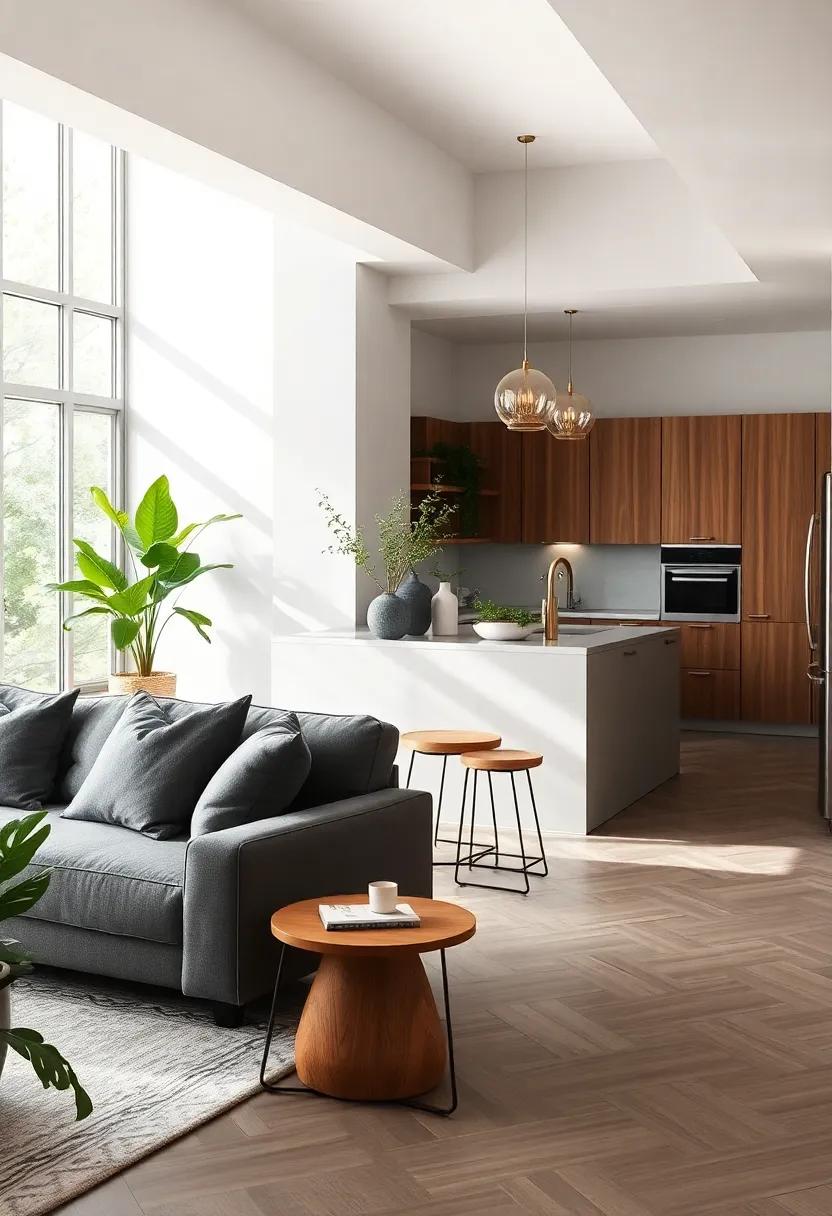
Incorporating a thoughtfully curated color palette can significantly transform your open concept living room kitchen into a serene oasis that encourages you to connect with nature. Greens, browns, and earthy tones evoke the rich hues of the outdoors, creating an inviting atmosphere.Consider utilizing paint, fabric, and decorative items that embody shades of olive, sage, and moss. These colors not only complement the greenery but also establish a seamless connection between indoor and outdoor elements. Adding accents of soft, warm neutrals like beige or taupe can offer balance, helping to ground the space while maintaining a fresh and airy feel.
In addition to the main color scheme, incorporating natural textures can further enhance your design. Think about integrating materials such as wood, stone, or woven fabrics, which can harmonize with the color palette to bring a sense of organic authenticity to your space. A well-placed table or a cozy area rug can soften the aesthetics and provide comfort, while carefully chosen accessories, like indoor planters and natural fiber throws, can bridge the gap between nature and your interior. Here are some features to consider:
- Complementary Colors: Pair greens with complementary warm tones for visual interest.
- Accent Walls: Consider painting one wall a bold green to serve as a focal point.
- Textured Elements: Use leafy patterns in textiles or art to bring dynamic energy into the room.
To visualize the impact of your chosen color palette, here’s a rapid reference table for organizing thoughts and ideas:
| Color | Emotion | Complementary Elements |
|---|---|---|
| Olive Green | Calm | Wood accents, gray furniture |
| Earthy Brown | Grounded | Stone decor, textural fabrics |
| Sage | Peaceful | Warm neutrals, metallic accents |
For more insights on selecting color palettes that reflect nature’s beauty, visit Architectural Digest.
Focal Points: Designing a Stunning Green wall Feature
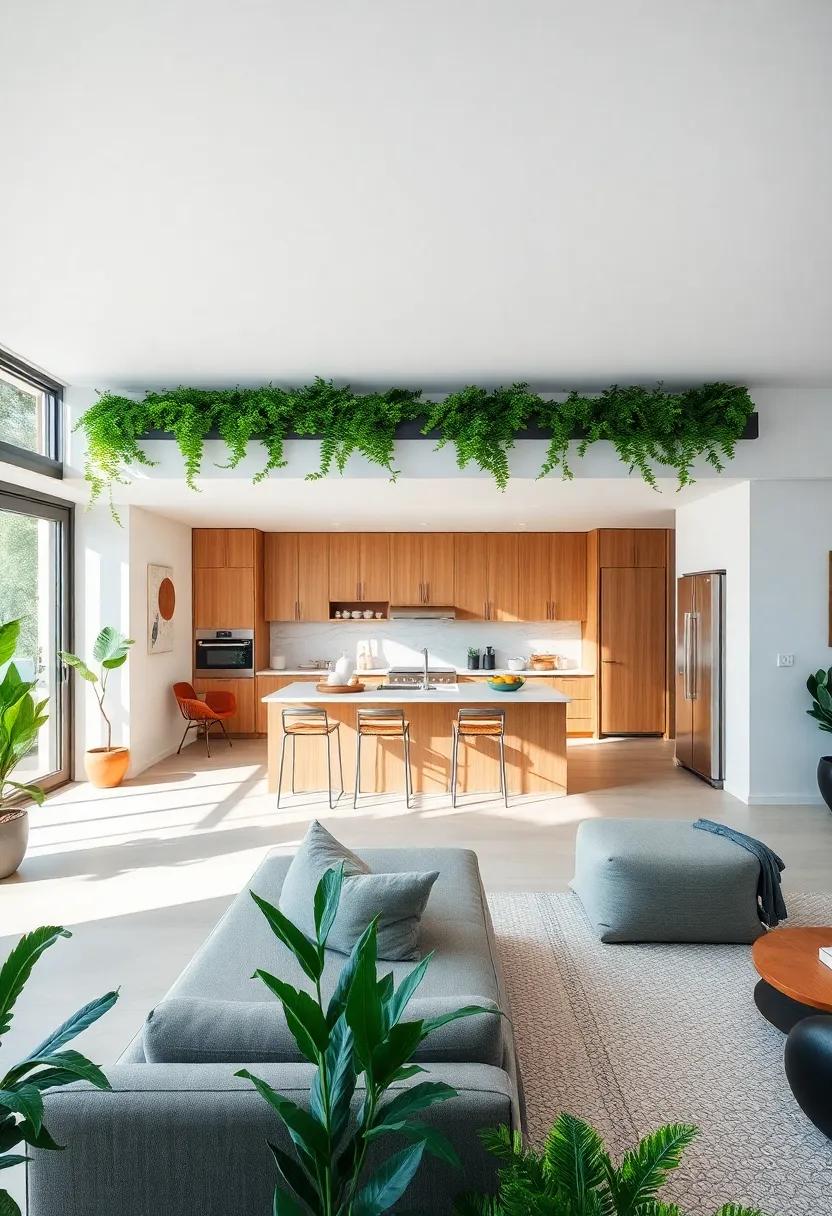
Integrating a green wall into your open concept space can transform an ordinary living area into a verdant oasis. Start by selecting a wall that receives indirect sunlight for the most vibrant growth. The choice of plants is crucial—consider a mix of ferns, ivy, and succulents for diverse textures and colors. You can enhance the layout further by adding vertical planters or shelving that allows for both greenery and decorative pieces. This creates depth and interest, making your green wall a stunning focal point that reflects your unique style.
To maintain a stunning green wall feature, a few design fundamentals come into play. Ensure proper irrigation systems to keep your plants hydrated without excess water pooling. Select lightweight pots and planters that are easy to rearrange if needed. Consider pairing your green wall with ambient lighting or artistic elements like hanging frames or mirrors to amplify the sense of space and color. Additionally, educate yourself on plant care by visiting resources such as Gardeners.com for inspiration and maintenance tips that will keep your indoor jungle thriving.
Inviting Fresh Air: Indoor Plants That Thrive in Open Concepts
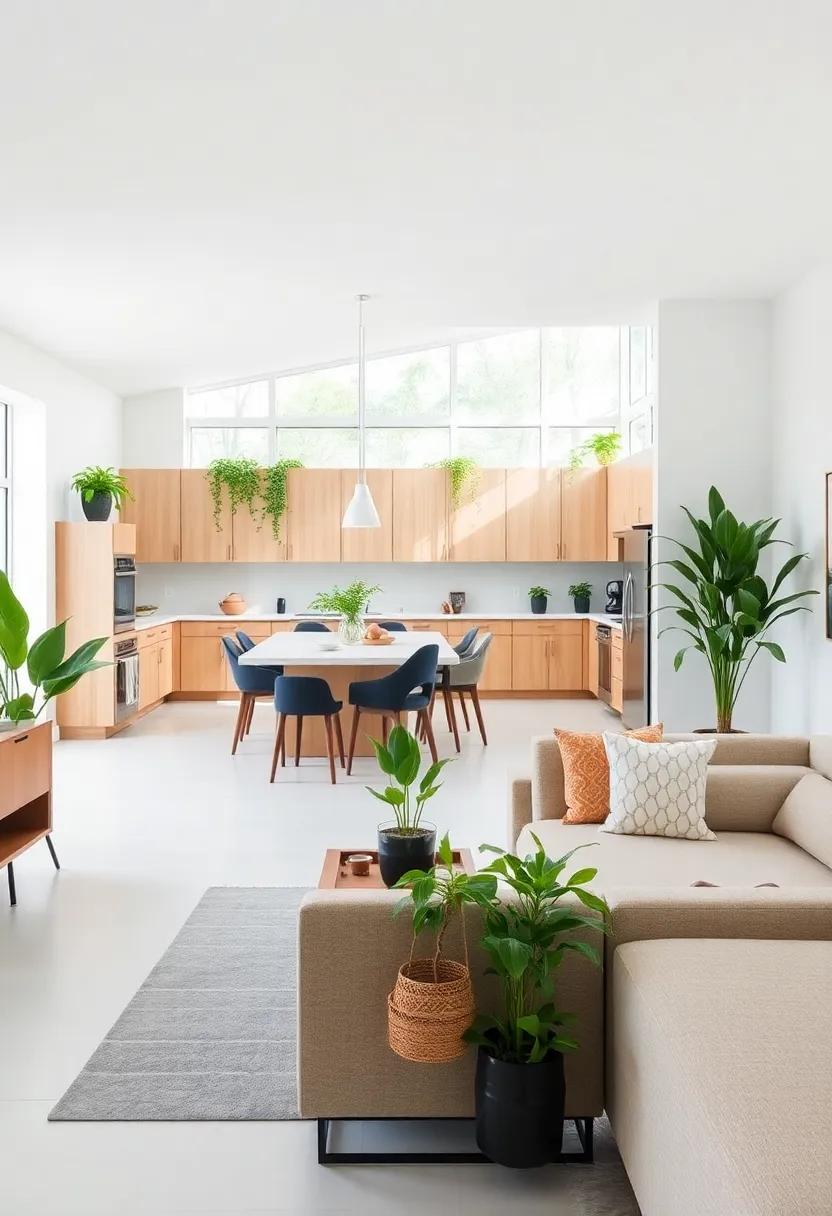
For an open-concept living room kitchen, selecting indoor plants that thrive in well-lit spaces can transform the ambiance into a refreshing oasis. Peace lilies not only purify the air but also produce elegant white blooms, making them a perfect choice for both aesthetics and health. Pothos, with its cascading vines, is incredibly adaptable and can thrive in various lighting conditions, thriving best in indirect sunlight. Snake plants, known for their resilience, can survive neglect and still add a striking architectural element to your decor with their upright leaves.
To ensure a cohesive design, consider placing plants at various heights to create depth. Utilize shelves, hanging planters, or plant stands to exhibit the beauty of greenery artfully.You might also create a mini indoor herb garden on the kitchen counter; think about including basil,sage,and thyme in small pots,combining functionality with flair. Incorporating a vertical garden can also be an unusual way to enhance the style of your open space while optimizing air quality.For more plant inspiration and care tips, visit The Houseplant Guru.
Functional Zones in Open Spaces Enhanced by Greenery
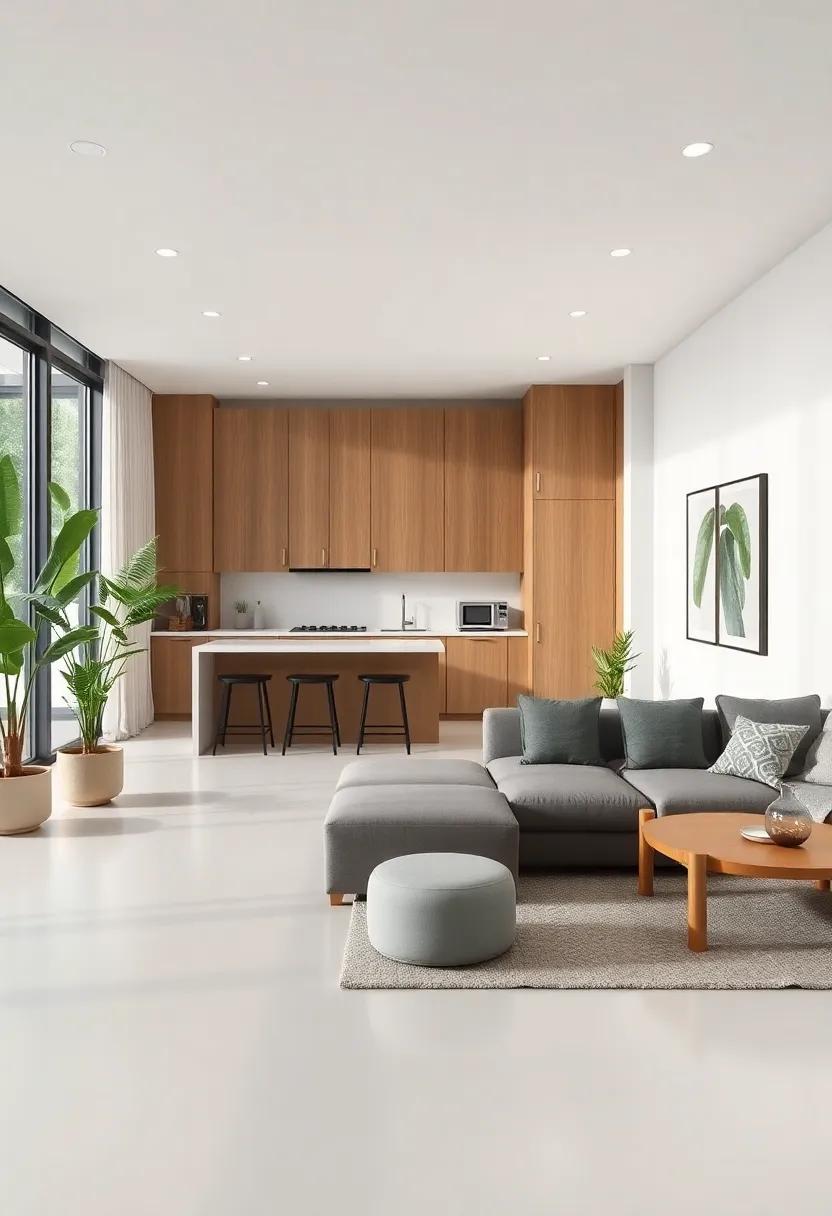
In the heart of your open concept living space, functional zones can be cleverly defined by incorporating greenery that enhances both aesthetic and practicality. By using plants as natural dividers, you can create distinct areas for cooking, dining, and lounging. Indoor plants like tall palms or elegant fiddle leaf figs serve as visual barriers, giving each space a sense of identity while maintaining an open feel. Placing herb pots on a kitchen windowsill not only beautifies the cooking area but also brings culinary treats directly to your fingertips, subtly blending functionality with vibrant décor.
strategically chosen greenery can also influence the mood of each zone. As an example, low-maintenance succulents can adorn shelves in the lounge area, promoting relaxation with their soothing presence, while hanging planters can add a dynamic element above dining spaces, encouraging social interaction.Consider creating a green wall using climbing plants that can act as an artwork centerpiece. This not only enriches the visual landscape but also improves indoor air quality, supporting a healthier living environment. Learn more about integrating greenery into your design philosophy at Gardenista.com.
Artistic Accents: Nature-Inspired Decor for a Cozy Atmosphere
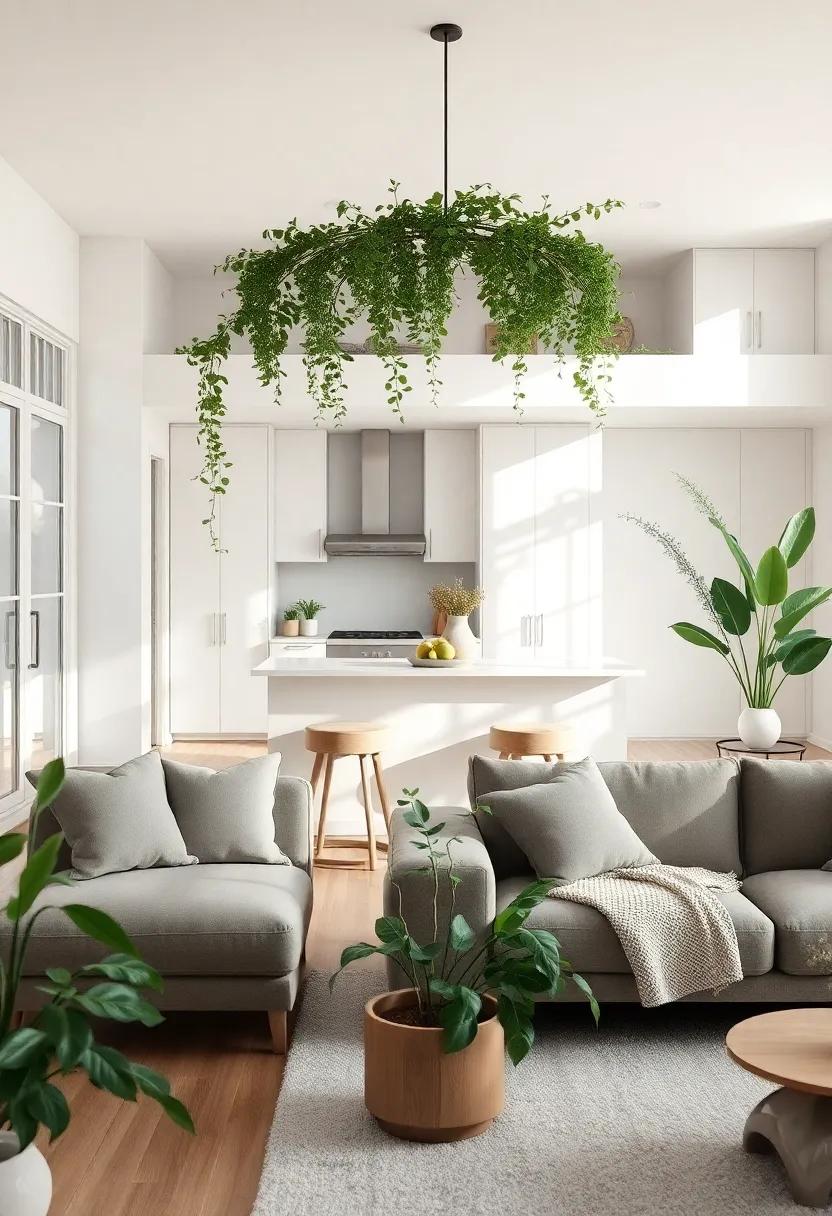
Incorporating natural elements into your living space can transform the ambiance into a serene retreat. Choose plants that thrive indoors, such as ferns, snake plants, or pothos, which not only purify the air but also add vibrant greenery to your decor. Layering textures with woven baskets, wooden accents, and ceramic pots can enhance the cozy vibe, creating a harmonious blend of nature and comfort. Opt for a color palette inspired by the outdoors – soft greens, earthy browns, and hints of floral pastels work beautifully to evoke a tranquil atmosphere.
Bring the beauty of the forest inside by utilizing nature-inspired decorative elements. Consider incorporating art pieces that feature botanical prints, or create a feature wall with nature-themed wallpaper that can act as a stunning backdrop for your kitchen and living area. You might also explore the idea of an indoor vertical garden, where you can display a medley of herbs and small plants, not only beautifying the space but also providing fresh ingredients for your meals. To further enrich the lifestyle, remember that using upcycled wood and natural fibers in your furnishings not only supports sustainability but also adds character to your home.
| Element | Purpose |
|---|---|
| Indoor Plants | Air purification and aesthetic appeal |
| Woven Baskets | Storage and texture enhancement |
| Botanical Art | Visual connection to nature |
| Indoor Vertical Garden | Space-saving greenery and fresh herbs |
For additional inspiration on nature-infused decor, visit Apartment Therapy.
textures and Layers: Combining Fabrics with Natural Elements
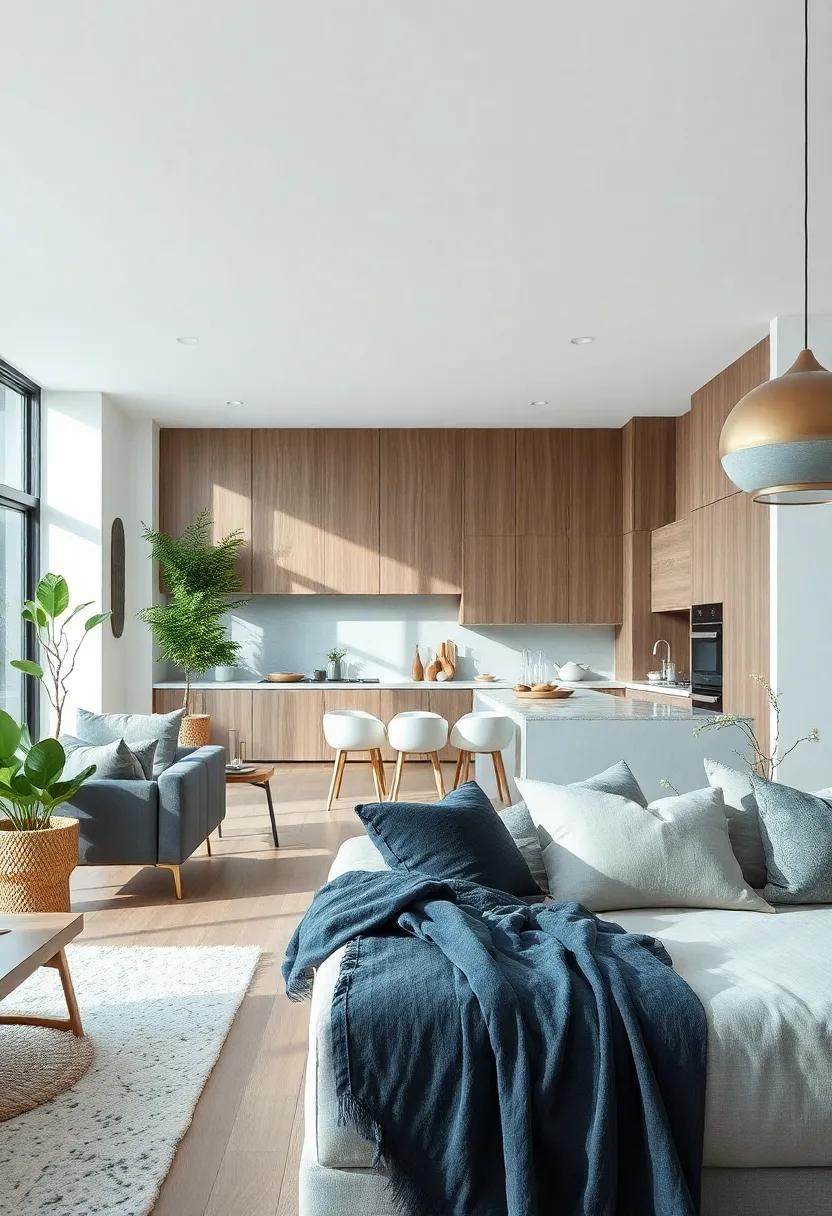
To transform your open concept living room kitchen into a serene oasis, consider layering various textures that reflect the beauty of the natural world. By incorporating soft linens, cozy wools, and rustic jutes, you can create a tactile experience that enhances the inviting atmosphere. Infuse your space with nature-inspired fabrics—think organic cotton cushions, rattan accent chairs, and hemp table runners. Below are some essential fabrics to consider:
- Natural Cotton – Breathable and versatile, perfect for cushions and curtains.
- Jute – Adds an earthy feel, ideal for rugs or table mats.
- Linen – Luxurious and effortless, perfect for drapery that moves with the breeze.
bringing in natural elements can elevate the aesthetic even further. Incorporate wooden accents, stone elements, and indoor plants to harmonize with your fabric choices. A reclaimed wood coffee table or a live-edge countertop can serve as stunning focal points that bridge the gap between indoor comfort and the beauty of the outdoors. A curated selection of plants not only breathes life into your space but also provides a vibrant texture contrast. consider showcasing your plants in handmade terracotta pots, which seamlessly blend natural materials with artful design.
| fabric Type | Texture | Best For |
|---|---|---|
| Canvas | Sturdy | Upholstery, Bags |
| Sisal | Natural | Rugs, Wall Hangings |
| Wool | Warm | Throw Blankets, Pillows |
For more inspiration on merging natural elements with your decor, visit Apartment therapy, where you’ll find a wealth of ideas to enhance your living space.
Unique Planter Ideas to Accentuate Your Living Kitchen Space
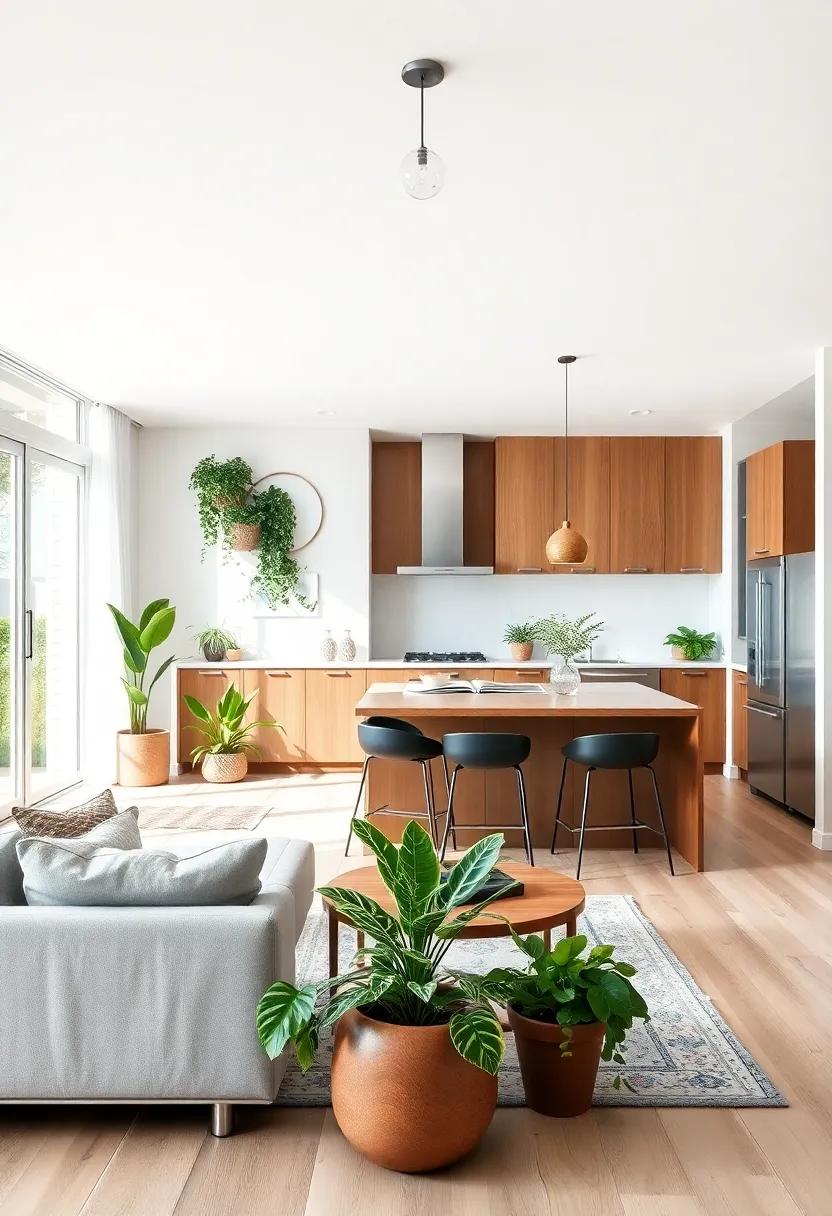
Transform your open concept kitchen and living room into a vibrant oasis with distinctive planting solutions that bring life and freshness indoors. Consider using vertical gardens that not only save space but also create a stunning focal point. Hanging planters filled with herbs like basil, thyme, and mint can be both aesthetic and practical, providing fresh ingredients right at your fingertips. For a whimsical touch, add suspended glass terrariums filled with air plants or succulents, allowing you to display greenery without taking up valuable surface space. Combine these ideas for a layered look, showcasing your plants at varying heights to maintain visual interest.
Creating an inviting atmosphere is also about incorporating unique planter designs that reflect your personal style. Repurposed items such as wooden crates, old teacups, or even vintage colanders can make fabulous and eco-friendly planters. For a sleeker appearance, opt for minimalist pots made from concrete or ceramic, which can effortlessly blend with modern decor. Don’t forget to establish a table or windowsill garden, where a curated assortment of small potted plants can thrive. you might choose to rotate plants seasonally to keep the space dynamic. to explore more creative ideas on integrating plants into your home,visit housebeautiful.com.
Sustainable Choices: Eco-Friendly Furnishings and Materials
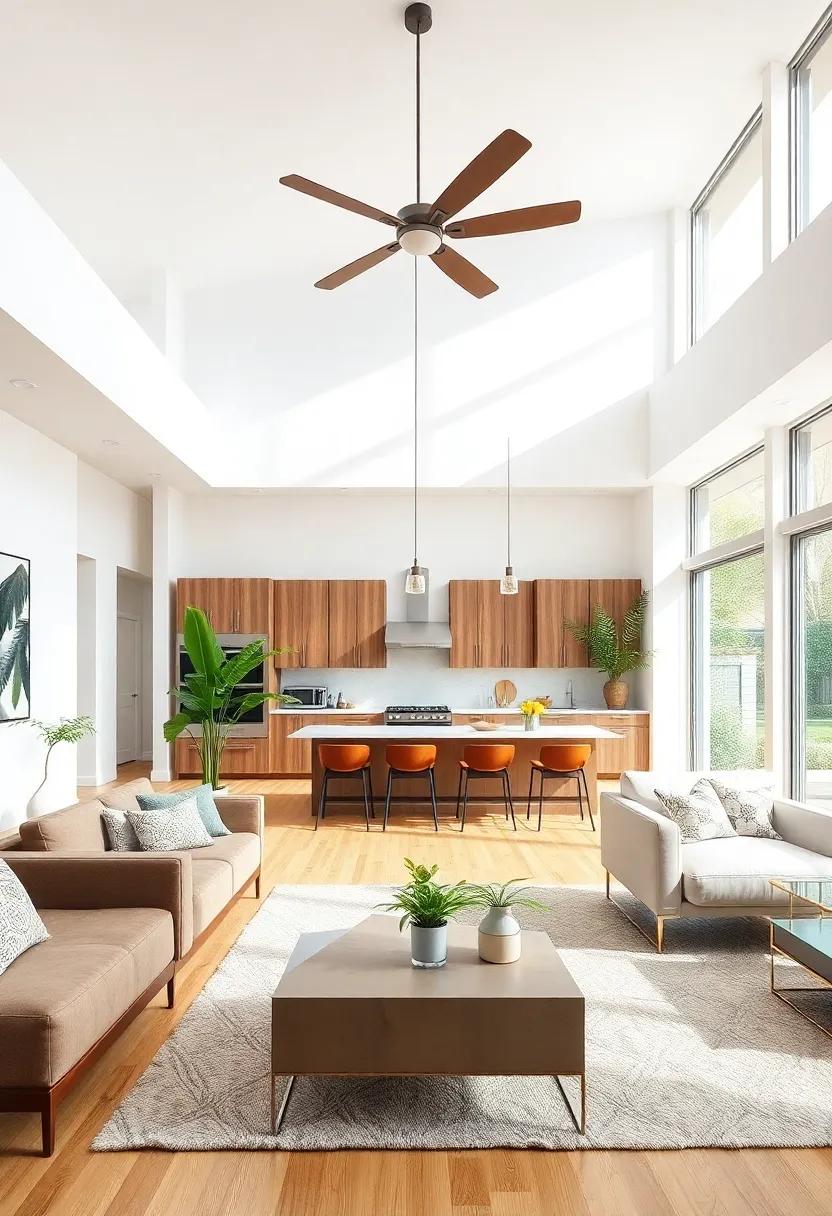
In the heart of sustainable design, choosing eco-friendly furnishings and materials plays a pivotal role in creating a serene living space that mirrors the surrounding nature. From reclaimed wood tables to organic cotton sofas,sustainable choices not only enhance the aesthetics of your open concept living room kitchen but also contribute to a healthier environment. Consider selecting furnishings made from materials that are sourced responsibly. Some appealing options include:
- Bamboo: A fast-growing, renewable resource.
- Recycled Materials: furniture crafted from repurposed items reduces waste.
- Natural Fibers: Wool, jute, and hemp are biodegradable choices for rugs and textiles.
- Low-VOC Finishes: Safer for indoor air quality and less harmful to the planet.
To further enhance the eco-friendly aspect of your space, embracing lush greenery is essential. Plants serve not only as stunning decor but also improve indoor air quality and create a calming atmosphere. Strategically placing indoor plants can encourage a seamless transition between your living room and kitchen, allowing nature to be a central element of your design. Incorporate various species such as:
- Snake Plants: Low maintenance and excellent air purifiers.
- Pothos: Versatile and can thrive in low-light conditions.
- Fiddle Leaf Figs: Dramatic foliage that adds height and character.
- Herb Gardens: functional and fragrant, perfect for culinary enthusiasts.
by harmonizing your interior design with sustainable materials and vibrant plants, you create not just a living space, but a sanctuary that nurtures both the inhabitants and the planet. For more inspiration on eco-friendly practices in home decor, check out Green Home Guide.
Crafting an inviting Atmosphere with Natural Lighting Techniques
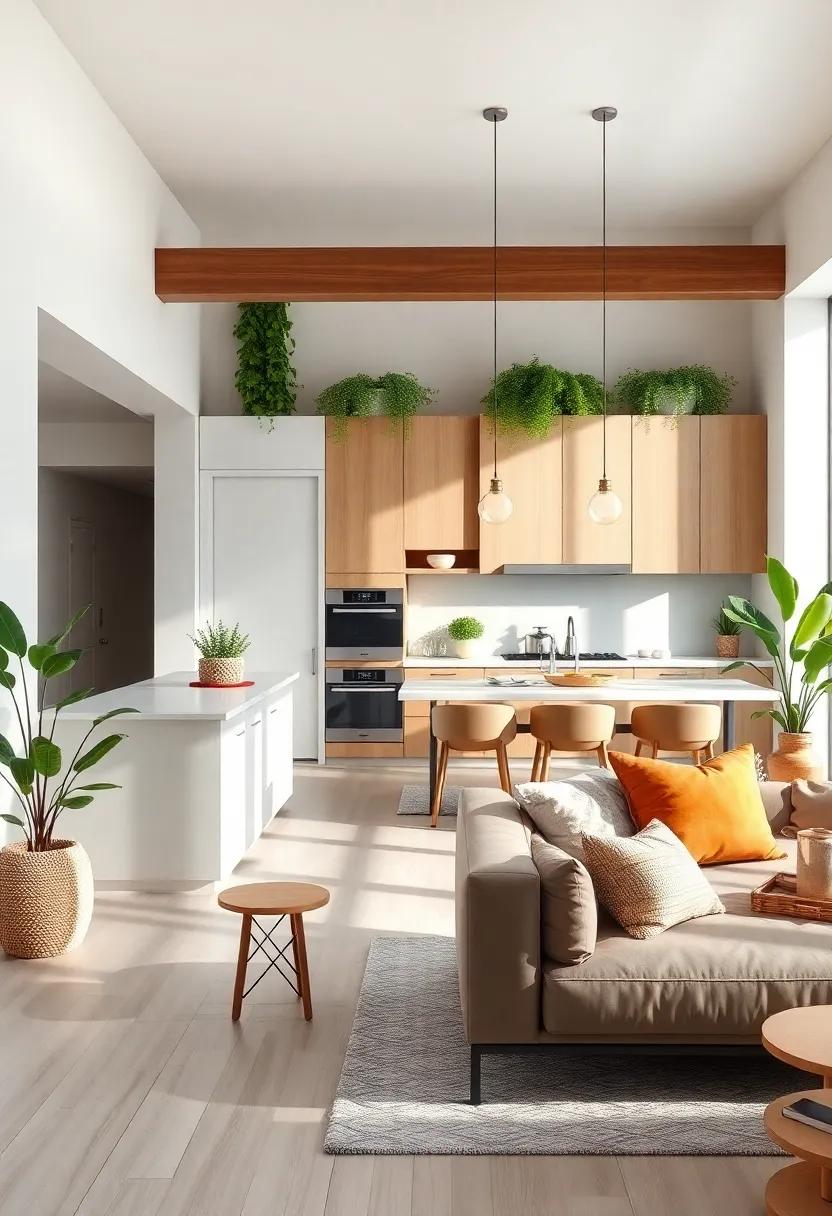
Creating a soothing and warm environment in your open concept living room and kitchen begins with harnessing the power of natural light. Consider incorporating large windows that stretch from floor to ceiling, allowing the sunshine to flood in and illuminate both spaces. Additionally, the use of skylights can dramatically brighten up areas that might or else receive limited daylight. Positioning mirrors strategically can also enhance the effect, as they reflect light and make the space feel larger and more airy. Don’t forget about the power of light-colored furnishings and decor, which can help to amplify the brightness while maintaining a serene atmosphere.
To further enhance the inviting ambiance, think about using sheer curtains that allow daylight to filter through while providing privacy. You can also integrate open shelving that displays vibrant plants, juxtaposing the greenery against the sunlit backdrop. Remember to balance your lighting choices by incorporating task lighting in areas like the kitchen without competing with the natural light. for an added touch, consider a table with plants that not only beautifies your dining area but also adds to the overall tranquil vibe. Such designs embrace nature while fostering a harmonious flow between your living space and the outdoors.
| Lighting Technique | Effect |
|---|---|
| Large Windows | Maximizes natural light |
| Skylights | Brings light from above |
| Mirrors | Enhances brightness and space |
| Sheer Curtains | Filters light while maintaining privacy |
for more inspiration on crafting a naturally lit home, visit Houzz, a wonderful resource for innovative interior design ideas.
Exploring Different Styles of Greenery for Diverse Vibes
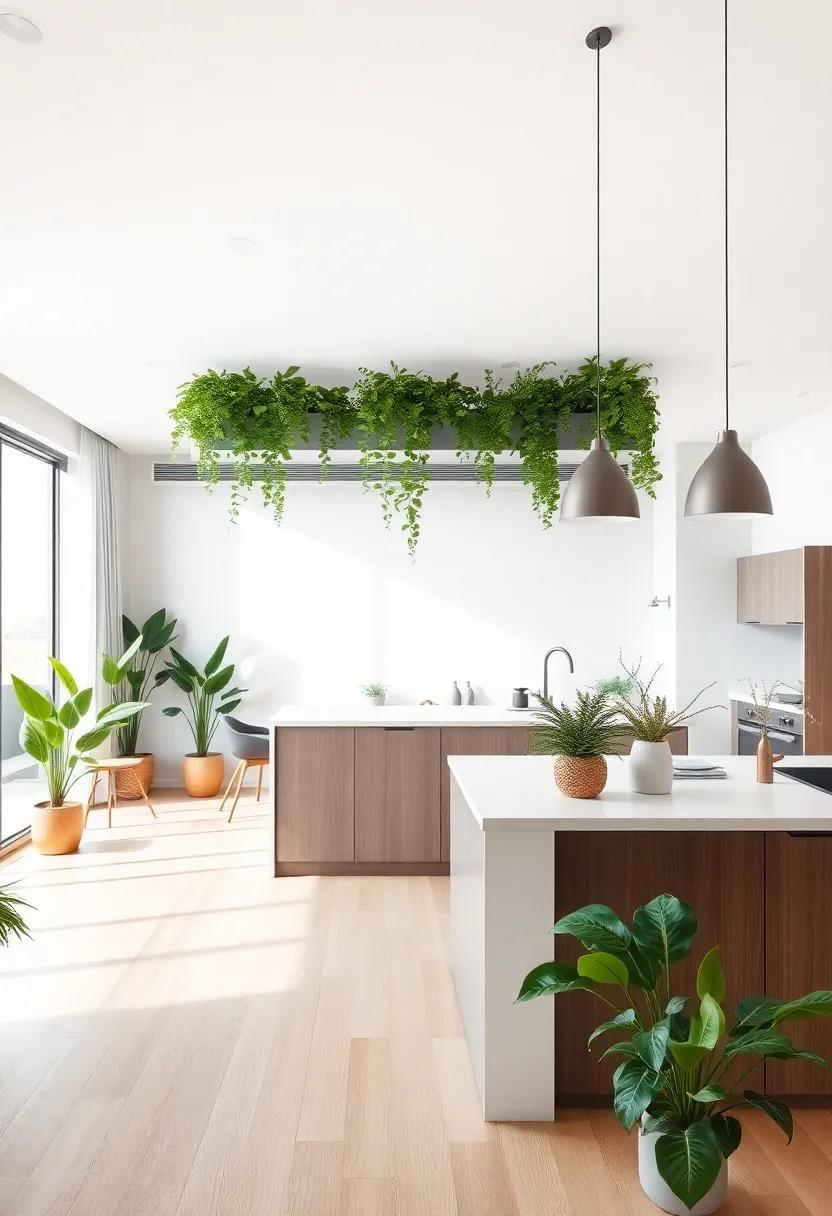
Incorporating greenery into your open concept living room and kitchen can create a dynamic environment that resonates with your personal style. There are various styles of plants that can evoke different vibes, enhancing the overall aesthetic of your space. For a minimalist look, consider using succulents or cacti to add some subtle charm with their clean lines and simple forms. If you prefer a more tropical ambiance, large-leafed plants like monstera or fiddle leaf figs can serve as stunning focal points that bring warmth and vibrancy. Alternatively, a combination of hanging plants, such as string of pearls or pothos, can add dimension and a touch of whimsy without occupying precious floor space.
To further personalize your greenery arrangement, think about grouping plants based on their shapes and colors to create a cohesive look. here are some ideas to consider:
- Textured Variety: Mix rough-textured plants like snake plants with soft, feathery ferns.
- monochromatic Palette: Use different shades of green to create a harmonious environment.
- Seasonal Rotation: Change plants according to the seasons to keep your space fresh and lively.
| Plant Type | Vibe Created |
|---|---|
| Succulents | Calm & Minimal |
| Monstera | Tropical & Lush |
| Pothos | Relaxed & airy |
When selecting your plants, consider their placement in relation to natural light and decor style. For more inspiration and tips on incorporating greenery into your home, check out Dwell, where you can explore a wealth of ideas that seamlessly blend nature with contemporary living.
Utilizing Vertical Space for Lush Green Displays and Gardens
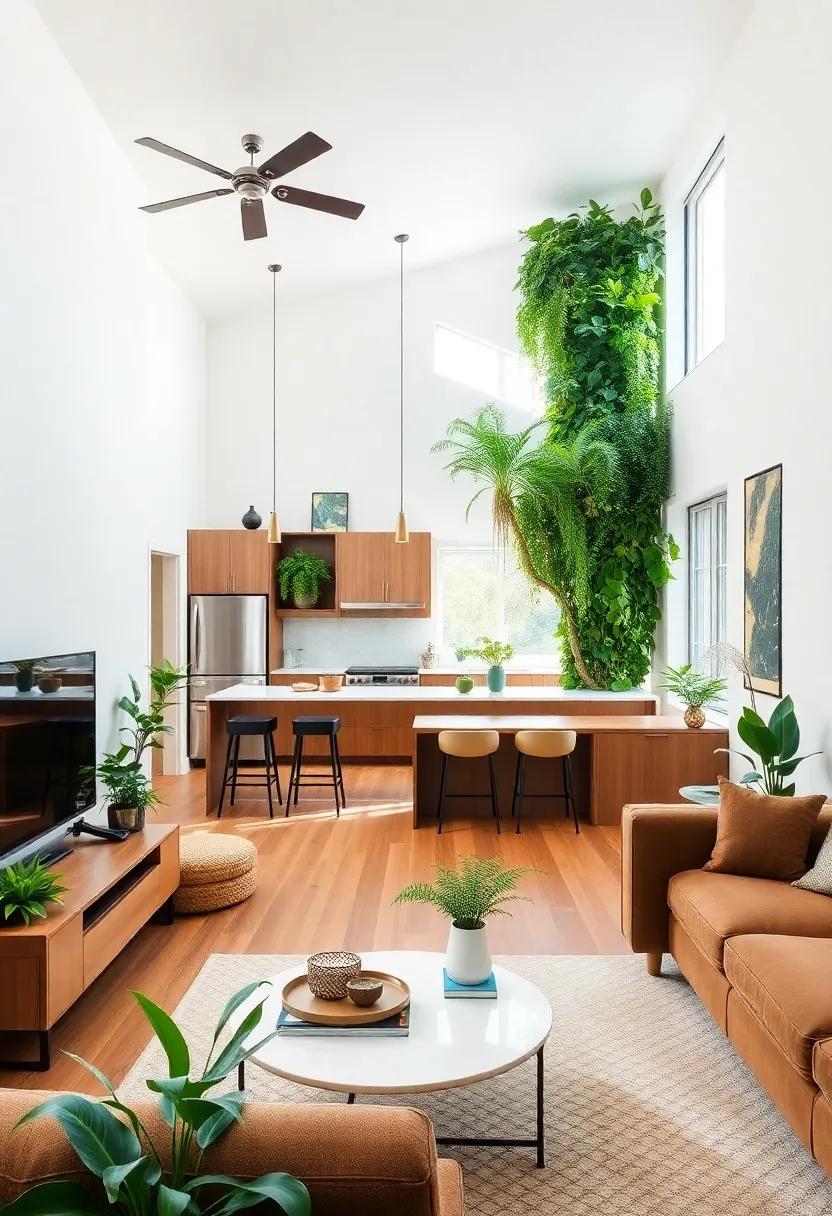
One of the most effective ways to maximize space while adding a lush, green feel to your open concept living room kitchen is to integrate vertical gardens. Utilizing walls, shelves, and even hanging frameworks allows you to create vibrant displays that draw the eye upward, transforming plain surfaces into living art. Consider incorporating a mix of climbing plants, hanging pots, and wall-mounted planters that can house an array of leafy greens or colorful blooms. This not only enhances aesthetics but also improves indoor air quality, making your space feel fresher and more inviting.
When designing these vertical displays, it’s essential to select appropriate plants that thrive in your environment.Here are a few options to consider for a stunning green backdrop:
- Philodendron: Perfect for trailing down shelves or hanging planters.
- Succulents: Great for low-maintenance decor with unique shapes.
- Herbs: Functional and fragrant, ideal for the kitchen area.
- Spider plants: Resilient and excellent air purifiers.
To enhance the appeal further, consider introducing a living wall system that can be customized with modular planters and integrated irrigation systems. By strategically arranging plants in an attractive grid or organic form, you can create a calming focal point that effortlessly blends your indoor and outdoor spaces. For inspiration on vertical gardening techniques, check out Gardenista.
Hybrid Spaces: Merging Cooking and Leisure Surrounded by Nature
Imagine a space where the boundaries between cooking and leisure blur seamlessly, creating an environment that caters to both our culinary passions and our need to unwind.An open concept living room kitchen enhances this experience by allowing natural light to flood the area while inviting the vibrant colors and sounds of nature indoors.With large windows or glass doors that open into a lush garden,the fragrance of herbs and flowers becomes an integral part of your home. To bring this concept to life,consider integrating natural materials and earthy tones,which create a harmonious ambiance that resonates with the tranquility of the outdoors.
Essential elements to achieve this inviting hybrid space include:
- Indoor Plants: Incorporating potted herbs or vertical gardens in your kitchen not only adds beauty but also ensures freshness in your meals.
- Outdoor Decking: Extend your kitchen’s functionality by creating a seamless space that flows into an outdoor dining area.
- Natural Light: Use skylights or wide glass doors to ensure that the interior is bathed in sunlight, boosting mood and productivity.
- Functional Furniture: Opt for pieces that blend comfort and utility, like a dining table that doubles as a food prep area.
| feature | description |
|---|---|
| Biophilic Design | Incorporating nature into design to enhance well-being. |
| Multifunctional Spaces | Areas that serve cooking, entertaining, and relaxing. |
| Eco-Friendly Materials | Use of sustainable woods, stones, and finishes. |
By merging the art of cooking with the joys of nature, you create a sanctuary that not only serves as a culinary hub but also as a peaceful retreat. This concept allows for enjoyment beyond meal readiness; it encourages relaxation amidst greenery, fostering a lifestyle that embraces well-being. To explore more ideas on integrating nature into your home, visit Architectural Digest.
Closing Remarks
As we conclude our exploration of the harmonious fusion between open concept living spaces and the beauty of nature, it’s clear that embracing greenery within our homes can transform not just our interiors, but our overall well-being. By thoughtfully incorporating plants, natural materials, and light, we create not only a visually inviting environment but a sanctuary where we can reconnect with the outdoors, even from the comfort of our own homes.
Imagine sipping your morning coffee amidst flourishing leaves or gathering with loved ones under a canopy of greenery—these moments remind us of nature’s presence and power. as you embark on your own design journey,remember that every detail counts. Whether it’s selecting the perfect potted plant or designing the layout to maximize sunlight, each choice invites a breath of freshness into your daily life.
So, as you step into your next project, let the essence of nature guide you.Open the doors to creativity,cultivate your space,and relish the tranquil beauty that lush greenery can offer.In a world that frequently enough rushes by,let your home be a testament to the serenity and rejuvenation that nature brings,inviting you to pause,breathe,and simply be.
Incorporating nature’s beauty into your open concept living room and kitchen not only enhances the aesthetic appeal of the space but also promotes a sense of well-being and tranquility. By thoughtfully selecting natural materials, introducing greenery, and maximizing light, you can create a harmonious environment that invites relaxation and creativity. Embrace the freedom of an open layout, allowing for seamless interaction and flow between areas. As you embark on your change journey,remember that every little detail counts—whether it’s a statement plant,a rustic wood element,or a shining splash of colour. Your beautiful, functional space awaits, a true reflection of your personal style and a nurturing haven for you and your loved ones. Happy decorating!
As an Amazon Associate I earn from qualifying purchases.


